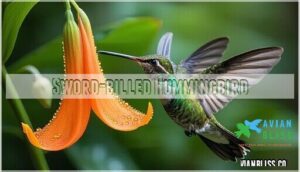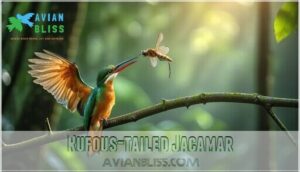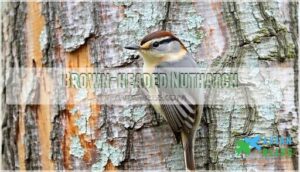This site is supported by our readers. We may earn a commission, at no cost to you, if you purchase through links.
 You’ll find that a small bird with long beak typically belongs to specialized species like hummingbirds, wrens, or nuthatches.
You’ll find that a small bird with long beak typically belongs to specialized species like hummingbirds, wrens, or nuthatches.
These birds have evolved elongated bills to access nectar deep inside flowers, probe tree bark for insects, or reach food sources other birds can’t touch.
The sword-billed hummingbird’s beak actually exceeds its body length, while brown creepers use their curved bills to extract insects from bark crevices.
Wrens sport needle-sharp beaks perfect for catching tiny prey in dense vegetation.
Each species has developed its unique beak shape and length to match its preferred food source and habitat, creating nature’s perfect feeding tools, which are a result of their evolution to access deep inside flowers and preferred food sources.
Table Of Contents
- Key Takeaways
- Small Birds Overview
- Long Beak Advantages
- Bird Species Examples
- Beak Specializations
- Conservation Status
- Frequently Asked Questions (FAQs)
- What bird has a beak longer than its body?
- What is the bird with the longest beak called?
- What kind of bird has a big beak?
- What is a wren like bird with a long beak?
- Which is the bird that has the long beak?
- What bird has a long beak like a hummingbird?
- What is a long-billed water bird?
- What is a small bird with a long beak?
- Which is the bird that has a long beak?
- What kind of bird has a long mouth?
- Conclusion
Key Takeaways
- You’ll discover that long beaks give small birds three major survival advantages: they can reach deep food sources other birds can’t access, avoid predators more effectively, and attract better mates during breeding season.
- You can identify these specialized birds by looking for species like wrens with needle-sharp beaks for catching insects, hummingbirds with tube-like bills for reaching flower nectar, and nuthatches with curved beaks for probing bark crevices.
- You’ll find that each bird’s beak acts like a precision tool designed for specific tasks – the Sword-billed Hummingbird’s 4-inch beak reaches deep tubular flowers while kingfishers use dagger-like bills for catching fish underwater.
- You should know that many of these remarkable birds face serious conservation threats from habitat destruction, invasive predators, and climate change, making wetland and forest protection essential for their survival.
Small Birds Overview
You’ll find that small birds with long beaks are perfectly adapted for reaching insects hidden in tree bark, flower nectar, and underground burrows.
Nature’s precision tools: these tiny acrobats wield their needle-sharp beaks like surgical instruments, unlocking hidden treasures other birds can’t reach.
These compact avian species use their specialized beaks to access food sources that other birds can’t reach, making them incredibly efficient foragers in their natural habitats.
Bewick’s Wren
Spotting a Bewick’s Wren means you’ve found one of nature’s most adaptable small birds with a distinctively long, slightly curved beak.
This gray-brown songster measures just 5.5 inches and thrives in scrubby woodlands across the eastern United States.
Key Bewick’s Wren Features:
- Bewicks Habitat: Prefers brushy areas, woodland edges, and suburban gardens
- Diet Details: Hunts spiders and insects using its specialized long beak
- Identification Tips: Look for white eyebrow stripe and cocked tail posture
- Wren Behavior: Known for melodious songs and curious, active foraging habits
To guarantee proper nutrition, consider the best food options for these wrens.
House Wren
You’ll find House Wrens practically everywhere, from city parks to your backyard birdhouse.
These adaptable small birds with moderately long beaks measure just 5.1 inches and weigh 11 grams.
Their House Wren Diet consists entirely of insects, while their Nesting Habits include using unusual spots like old boots or tin cans.
Urban Habitats suit them perfectly, showcasing remarkable Wren Adaptations for city living.
Consider purchasing a House Wren birdhouse to attract these birds to your yard.
Marsh Wren
You’ll recognize the Marsh Wren by its distinctive long beak and secretive nature in wetland areas.
This small bird thrives in marsh habitat, weaving dome-shaped nests among cattails and sedges. Their complex vocalizations include buzzy trills that echo across waterways.
Geographic distribution spans North America’s wetlands, where they hunt insects and spiders.
Their nesting behavior involves multiple dummy nests built by males, which are part of their unique mating rituals, and showcases their complex social interactions, particularly in their secretive nature.
Winter Wren
You’ll find the Winter Wren thriving in harsh Arctic adaptation zones across North America, Europe, and Asia.
This small bird with long beak measures just 4 inches but packs remarkable resilience.
Their migration patterns shift between continents seasonally, while plumage variations showcase rich brownish-gray tones perfect for winter habitat camouflage.
They sometimes need help to maintain suitable habitats.
- Arctic adaptation: Survives extreme cold in coniferous forests with specialized feather insulation
- Migration patterns: Travels between North America and Spain during spring and summer months
- Winter habitat: Prefers marshes, bogs, and dense willow thickets near water sources
- Diet specifics: Hunts insects, spiders, snails, and invertebrates in ground cover
- Plumpage variations: Features brownish-gray coloring with subtle barring for effective concealment
Carolina Wren
Carolina Wrens charm bird watchers with their melodious whistles echoing through shrubby habitats.
You’ll recognize these small birds by their rusty-brown coloring and curved long beaks, perfect for their insect diet.
Their wren size makes them ideal backyard visitors, especially during nest building season when they’ll explore every nook for the perfect spot.
| Feature | Details | Notes |
|---|---|---|
| Size | 4.8 inches, 20 grams | Perfect wren size for identification |
| Habitat | Shrubby woodlands, suburbs | Thrives in dense vegetation |
| Diet | Insects, spiders | Long beak aids foraging |
| Behavior | Constant singing, territorial | Melodious whistles year-round |
Long Beak Advantages
You’ll discover that long beaks give small birds three major survival advantages in the wild.
These specialized tools unlock nature’s hidden treasures, giving tiny birds extraordinary power to thrive where others can’t.
These specialized tools help them reach deep food sources, avoid dangerous predators, and attract better mates during breeding season, providing complete concepts for survival, with specialized tools being key.
Foraging Benefits
You’ll discover that beak morphology directly impacts foraging efficiency in small birds.
Long beaks enable resource partitioning, allowing different species to access unique food sources without competition.
This niche adaptation creates remarkable diet versatility – wrens probe bark crevices while hummingbirds reach deep flower nectar.
Each bird’s specialized beak function maximizes their survival advantage through enhanced foraging strategies.
Different species have adapted to various methods of water-based foraging, requiring unique skills.
Predator Avoidance
Beyond feeding advantages, you’ll notice these birds have mastered bird survival strategies that keep them alive.
Their specialized beaks double as bird beak defense tools against threats.
Watch how they use Camouflage Techniques to blend seamlessly into bark and foliage.
When danger strikes, Evasive Maneuvers help them dart through tight spaces while Alarm Calls alert nearby birds to bird threats from predators.
Mating Success
Long beaks become powerful tools during courtship rituals, helping males attract mates through impressive displays.
You’ll witness American Woodcock males performing their sky dance with distinctive peent calls, while their long bills signal fitness to potential partners.
Bowerbirds arrange objects using forced perspective, creating optical illusions that directly correlate with matting success and female attraction rates.
Bird Species Examples
You’ll discover several fascinating bird families that showcase remarkable beak adaptations for their specific lifestyles.
These species range from tiny hummingbirds with needle-like bills to ground-dwelling kiwis with sensitive probing beaks, each perfectly suited for their unique feeding strategies.
Hummingbirds
You’ll find hummingbirds are nature’s aerial acrobats, showcasing remarkable hummingbird flight patterns while their long beak enables precise nectar feeding from tubular flowers.
These small birds play vital pollination roles across diverse ecosystems, with over 300 species displaying incredible diversity.
Their specialized bird beak design makes bird identification easier, though conservation challenges threaten many populations worldwide.
Sunbirds
Several hundred sunbird species showcase remarkable nectar feeding adaptations across Africa and Asia.
These vibrant small birds evolved specialized long beaks perfectly suited for extracting nectar from tubular flowers, making sunbird pollination essential for many plant species.
Their sunbird diversity spans multiple habitats from tropical forests to arid regions.
- Sunbird evolution produced curved, needle-like beaks for deep flower penetration
- Sunbird habitats range from rainforests to deserts across two continents
- Bird identification relies on iridescent plumage and distinctive feeding behaviors
- Bird beak structures vary by flower types in their native environments
- Bird species include olive-backed, purple, and variable sunbirds
Woodcocks and Snipes
Looking closely at these ground-dwelling masters, you’ll discover woodcocks and snipes share remarkable adaptations.
Their specialized long beaks probe soft soil for earthworms and invertebrates. Wilson’s Snipe prefers wetland margins while American Woodcock chooses young woodlands.
Long legs aid in wetland navigation for these birds.
Both species showcase incredible Camouflage Techniques, blending seamlessly into their surroundings through intricate Mating Rituals and specialized Migration Patterns.
| Feature | Wilson’s Snipe | American Woodcock |
|---|---|---|
| Habitat | Wetlands, shallow water | Young growth woodlands |
| Diet | Earthworms, larvae, invertebrates | Worms, slugs, ground insects |
| Markings | Bold back stripes, white belly | Gray stripes, cinnamon belly |
Kiwi Birds
Down in New Zealand’s forests, you’ll discover the remarkable kiwi, a flightless bird whose evolution produced extraordinary nocturnal habits and unique adaptations.
Their long beaks house nostrils at the tip, perfect for sniffing out insects underground.
Despite their cultural significance as New Zealand’s national symbol, these bird species face serious conservation challenges:
- Predator threats from introduced mammals
- Habitat destruction reducing nesting sites
- Low survival rates among chicks
- Vehicle strikes in populated areas
These challenges threaten the national symbol and require attention to protect the kiwi and its habitat, ensuring the long-term survival of this unique bird species with its extraordinary nocturnal habits.
Beak Specializations
You’ll discover that each bird’s beak acts like a specialized tool designed for specific tasks.
The Sword-billed Hummingbird’s 4-inch beak reaches deep into tubular flowers, while the Common Kingfisher’s pointed bill works perfectly for catching fish underwater.
Sword-billed Hummingbird
The Sword-billed Hummingbird stands apart from other hummingbirds with its remarkable four-inch beak that’s longer than its entire body.
This extraordinary beak adaptation allows it to reach nectar sources in deep tubular flowers throughout its Andean habitat.
You’ll find this bird species co-evolved with cloud forest plants, playing a vital pollination role while demonstrating unique flight mechanics to manage its oversized bill.
Rufous-tailed Jacamar
Rufous-tailed Jacamars showcase brilliant green plumage with distinctive rufous tail feathers.
You’ll find these bird species in Central and South American rainforests, where their long beak serves as a precision tool.
Their bird diet consists mainly of flying insects, particularly butterflies and dragonflies.
Watch them dart from perches with lightning speed, using their specialized bird beak to snatch prey mid-flight with remarkable accuracy.
Their beaks are specialized feeding tools, shaped by millions of years of adaptation.
Brown-headed Nuthatch
At just 4.5 inches long, the Brown-headed Nuthatch proves that size doesn’t limit specialization in bird species.
This small bird sports an oversized long beak perfectly adapted for Pine Woodland foraging. Their unique Nuthatch Behavior includes using tools to extract insects from bark crevices.
Social Structure involves family groups with distinct Vocalizations, while Nesting Habits favor old pine cavities where Brownheaded Nuthatch families thrive together.
Common Kingfisher
You’ll spot this brilliant small bird with long beak near calm waters worldwide.
The Common Kingfisher’s metallic blue and orange plumage makes identification easy, while its dagger-like beak proves perfect for precision fishing techniques.
- Fishing Techniques: Dives headfirst into water with eyes closed, relying on reflex timing
- Plumage Coloration: Metallic blue back contrasts with bright orange-copper breast feathers
- Habitat Preference: Favors slow-moving rivers, streams, and ponds with overhanging branches
- Diet Specifics: Primarily feeds on small fish, minnows, and aquatic insect larvae
- Global Distribution: Found across Europe, Asia, Africa, and parts of Australia year-round
Conservation Status
You’ll find that many small long-beaked birds face serious threats from habitat destruction, invasive predators, and climate change affecting their food sources.
Understanding these conservation challenges helps you appreciate why protecting wetlands, forests, and specialized feeding areas is essential for species like the Kiwi, various wrens, and specialized hummingbirds.
Habitat Loss
While these remarkable adaptations help small birds thrive, they’re facing an uphill battle against habitat destruction.
You’ll find that forest fragmentation splits up bird habitats, making it harder for species to find mates and food. Wetland destruction particularly impacts wren populations, while suburban sprawl eliminates essential nesting sites.
| Habitat Type | Primary Threat |
|---|---|
| Tropical Forests | Deforestation (70% degraded) |
| Wetlands | Drainage projects |
| Grasslands | Agricultural expansion |
| Urban Areas | Development pressure |
Small bird conservation depends on protecting these diverse ecosystems from further bird habitats loss.
Predator Threats
Invasive cats and rats pose serious threats to small bird populations with long beaks.
These predators excel at nest predation, destroying eggs and chicks in ground-level nests. You’ll notice these vulnerable species rely on camouflage tactics and anti-predator behavior like alarm calls to survive.
Habitat security becomes critical when predator identification reveals increased threats in fragmented landscapes where bird behavior changes dramatically, highlighting the need for habitat security.
Climate Change
Climate change disrupts everything you’d expect from nature’s delicate balance.
Rising temperatures trigger habitat shifts, forcing long-beaked birds into unfamiliar territories where food scarcity becomes their harsh reality.
Extreme weather destroys nesting sites while altered migration patterns leave species struggling to adapt.
These environmental pressures directly impact bird beak evolution and function, threatening species survival across diverse bird habitat preferences.
Conservation Efforts
Dedicated bird conservation efforts offer hope for threatened long-beaked species facing mounting pressures.
You can support these vital initiatives that protect our feathered friends:
- Habitat Restoration – Replanting native vegetation and creating wildlife corridors
- Predator Control – Managing invasive species that threaten nesting birds
- Public Awareness – Educating communities about biodiversity conservation and Legal Protection measures
Agriculture’s impact highlights the need for sustainable farming practices.
Frequently Asked Questions (FAQs)
What bird has a beak longer than its body?
Like nature’s own needle threading through air, you’ll find the Sword-billed Hummingbird defying proportions.
This tiny aerial acrobat carries a four-inch beak that’s nearly as long as its entire five-and-a-half-inch body length, showcasing its unique characteristic.
What is the bird with the longest beak called?
You’ll find the Sword-billed Hummingbird holds the record for longest beak relative to body size.
This remarkable bird’s beak actually exceeds its body length, measuring around four inches on a 5-inch frame.
What kind of bird has a big beak?
You’ll find several bird species with remarkably large beaks.
Toucans sport colorful, oversized bills for reaching fruit.
Pelicans have massive pouches for catching fish.
Hornbills display prominent beaks for diverse feeding needs, which includes remarkably large beaks and diverse feeding.
What is a wren like bird with a long beak?
You’ll encounter the Bewick’s Wren, a 5-inch songbird with gray-brown plumage and a distinctly long, downward-curved beak.
It’s perfect for probing deep into crevices while hunting spiders and insects in scrubby woodlands.
Which is the bird that has the long beak?
Nature’s needle-wielding artists come in many forms.
You’ll find hummingbirds with tube-like beaks, kingfishers with dagger-sharp bills, and woodpeckers with chisel-tipped tools.
Each species evolved its specialized beak for specific feeding needs and survival strategies.
What bird has a long beak like a hummingbird?
Several birds share hummingbirds’ long-beak design.
You’ll spot kingfishers with their dagger-like bills, nuthatches sporting needle-thin beaks, and brown creepers using curved bills.
Woodpeckers also feature elongated beaks for drilling into bark.
What is a long-billed water bird?
You’ll spot herons, egrets, and ibises wading through marshes and ponds. These elegant birds use their lengthy bills to spear fish, frogs, and aquatic insects with surprising precision and grace.
What is a small bird with a long beak?
Ever wondered about those tiny avian acrobats darting through your garden?
You’ll find wrens, nuthatches, and hummingbirds leading this long-beaked brigade.
These feathered specialists use their needle-like bills to probe flowers, bark crevices, and capture insects with remarkable precision.
Which is the bird that has a long beak?
You’ll find many birds with long beaks, but hummingbirds are particularly famous for their needle-like bills. Wrens, kingfishers, and woodpeckers also sport elongated beaks perfectly adapted for their feeding habits.
What kind of bird has a long mouth?
You’ll find many birds with long beaks, including hummingbirds, woodpeckers, and wrens.
These specialized bills help them reach nectar, insects, or seeds.
Each species evolved its beak shape for specific feeding needs.
Conclusion
Absolutely incredible adaptations have made each small bird with long beak a master of survival in its unique environment.
You’ve discovered how these remarkable species use their specialized bills to access food sources that remain off-limits to other birds.
From hummingbirds reaching nectar deep within flowers to nuthatches probing bark crevices, these evolutionary marvels demonstrate nature’s ingenuity.
Now you can identify these fascinating birds and appreciate the perfect relationship between form and function in the natural world.













